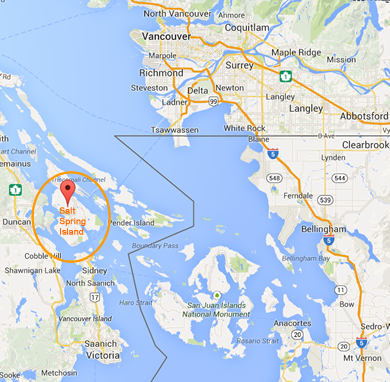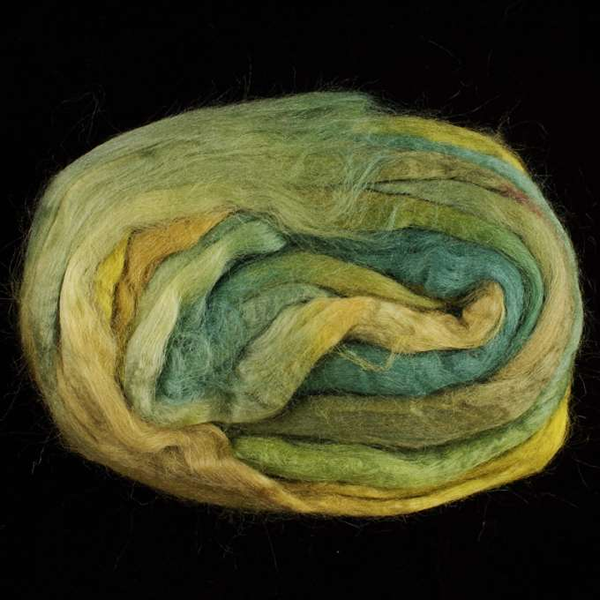Treenway Silks' - Salt Spring Island Colorways
View the Salt Spring Island Colorway here.
Shop - Salt Spring Island products here.
The original Salt Spring Island colorways were developed by Kim McKenna, Hues by Cheryl, Mary of Deerhaven Productions, Charlene Wolff and Treenway Silks. You can learn a lot more about each of these talented dyers in the September 2006, September 2007 and February 2011 newsletters.
We feel fortunate Kim had time to share her technical and artistic skills with us to help us get started in the development of this series. Kim has been weaving, spinning and dyeing while being a wife and mom and working. She teaches workshops and exhibits in galleries and shows. Kim uses her science background to help push the limits of the dyepot, but listening to her intuitive self leads to the exciting artistic discoveries.
The silk rovings are hand-painted by 100th Sheep (Peggy Doney).
A Bit About Salt Spring Island
View a tourist site about Salt Spring Island - here.
 Location map of Salt Spring Island - west of Vancouver, BC, Canada
Location map of Salt Spring Island - west of Vancouver, BC, Canada Salt Spring Island, the home of Treenway Silks founders Karen Selk and Terry Nelson, is the largest of the Canadian Gulf islands in the Georgia Strait at 17 miles long and 9 miles wide, situated midway between Victoria and Vancouver. There are 83 miles of shoreline, 8 lakes, 6 mountains and 225 farms. The island is known for its stunning views, natural beauty, extra-ordinary artisans, organic farms, dairies and vineyards. Visitors come for a relaxed, reflective holiday of hiking, cycling, kayaking, swimming, frisbee golf and attending the bustling, colorful and creative Saturday market.
The Treenway Silks founders are proud of their community and place on this planet and used it as the inspiration for the colorways of our dyed tussah sliver.
Imagine dancing to the colors at the beautiful spots on lovely Salt Spring Island.
The brilliant rovings can be used for: Spinning, Weaving, Knitting, Silk Fusion and whatever creative spark comes to mind!
To best judge the colors, order a sample card of the new Salt Spring Island Series!
Spinning Hand-Painted Silk Sliver
by Kim McKenna
All too often the colourful space-dyed slivers we are attracted to look muted or muddied-out once spun up and plied. One way to avoid this is to ply your sliver with yet another color — one that either complements all the other colours in the sliver or one that acts as a background or "jump–off" color. If, however, you want a plied yarn that is most like the sliver that you fell in love with in the first place, you can try the following easy technique. It requres an extra step but the results are well worth the little bit of extra time it takes:
First off, don't spin tip to tip right from the sliver until all your silk has been spun up. Instead, split the sliver in two along its length. Then, break off 3 foot lengths from the two splits of roving. Lay the 3 foot lengths side by side. Then start spinning from one of the splits keeping the 3 foot lengths in order so you can follow the same order for the second split on a second bobbin. When spinning your singles try to keep your treadling rhythm and length of draw back as consistent as possible.
Once you have spun each split into singles on their own bobbin, wind the singles off onto two new bobbins. When you do this, you will then have the point where you started spinning your singles on the outside and where you finished the singles on the inside of your bobbin (see note below). Now, ply these two singles together. You will see that the colors line up nicely and give a yarn that is very similar to the sliver you started out with.
Winding Singles Onto A Second Bobbin
For very fine yarn you can wind the singles onto shuttle bobbins using a bobbin winder. This goes quite quickly. Or, for thicker yarn, you can wind the singles around a small ball of yarn. I have made small felted balls to use for this. In the centre of each ball, I have a small pebble to give the ball of yarn some weight so it does not jump around too much when plying. Around the pebble I wound some yarn and then I felted a "skin" around the small ball of yarn. It took me about 30 minutes to make four small felted pebble balls but they have proven most useful over the years. The idea was sparked when visiting Thailand where they place a samll pebble or piece of wood in the centre of their ball of singes to make plying easier.
If my singles are spun Z, I wind them onto the bobbin or felted ball in a clockside direction so as not to remove any twist. If they are spun S, I wind them on anti–clockwise.

